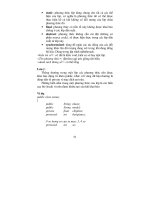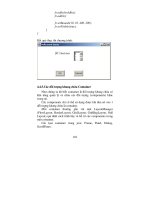Begin java having used alice
Bạn đang xem bản rút gọn của tài liệu. Xem và tải ngay bản đầy đủ của tài liệu tại đây (301.46 KB, 34 trang )
Begin Java having used Alice
Pepper
- Some slides from Alice in Action
with Java
Objectives
•
Write some first Java programs
•
Learn the basics of the BlueJ Integrated
Development Environment (IDE)
•
Begin making the transition from Alice to
Java
Alice vs Java
Alice Java
•
3D graphics let you
visualize programming
concepts
•
Drag-and-drop coding
reduces syntax errors
•
Create new objects -
•
Run Java programs
across various platforms
•
Build applets to make
Web pages interactive
Much of Alice is written in Java
A very simple Alice program
A Very Simple Java Program
public class JavaWorld {
public static void main(String[] args) {
System.out.println
("This is my first Java program.");
}
}
Class header
Method header
statements
Close braces mark
the end
Open braces mark
the beginning
A First Program – What Does It Do?
Prints the message
This is my first Java program.
Ends the line
System.out.println
("This is my first Java program.");
Same steps to create a program
Alice Java
Storywrite Design
Code Code
Compile
Play Run
Test Test
Make the Program Run
•
Compile (translate to java byte code)
•
Run (interpreter for that OS reads java
byte code and translates for machine)
Source
x.java
Compile
(javac x.java)
Object
x.class
Execute
(java x)
Development Environment
Blue Jay
Lets you enter code just like Alice did
Download at:
Instructions on syllabus
Exercise
•
Add the line “Welcome to Java”
•
When you run the program, you will see:
This is my first Java Program.
Welcome to Java.
•
Extra:
–
Info: print() does not go to the next line
–
Try splitting Welcome to Java into two
statements: “Welcome” and then “ to Java.”
A program that does something
Convert Dollars to Euros
Where to start?
Design possibilities
•
By words : Nouns and Verbs algorithm
•
By test data : List some possible inputs
and outputs before coding
•
By class diagram : Design object pictures
•
By flow chart : chart the sequential steps
and decisions
Designing by words
•
First step: write a user story to help setup
structure
•
User story for dollars-to-euros currency
conversion
–
Query user for dollar amount to convert to euros
–
Read the dollar amount from the user
–
Query user for euros-per-dollar exchange rate
–
Read euros-per-dollar exchange rate
–
Compute corresponding number of euros
–
Display dollar and (computed euros values)
Nouns objects
? = make a Class
Verbs -> Operations
The Algorithm
•
Algorithm: sequence of steps that solve a
problem
•
Algorithm for converting dollars to euros
–
1. Display "How many dollars do you want to
convert?"
–
2. Read dollars
–
3. Display "What is the euros-per-dollar
exchange rate?"
–
4. Read eurosPerDollar
–
5. Compute euros = dollars * eurosPerDollar
–
6. Display dollars and euros, plus descriptive
labels
Design by test data
•
Possible inputs and outputs:
Input
Dollar
Input euros
per dollar
Rate
Output Euros
10 100 1000
10.55 100 1055
10 .055 .55
0 100 0
100 0 0
Design by class diagram
DollarsToEuroConverter
main
Scanner
nextDouble
Keyboard Input
Design by flowchart
Ask for dollars
start
Read Dollars
Ask for rate
Read rate
Compute euros
Print euros
end
Let’s start coding – setup #1
Create a new project in BlueJ
Create a new class
Write the standard new World starter:
public class DollarsToEuroConverter {
public static void main(String[ ] args) {
}
}
Comments – setup #2
•
Comments:
–
Inline: begins comment with // and ends at
line’s end
–
Block (C-style): begins with /* and ends with
*/
–
Javadoc: begins with /** and ends with */
•
Add comments to your class now at the top:
/** DollarsToEurosConverter.java converts dollars to
euros.
@author you
*/
Public class DollarsToEurosConverter
Import Packages – setup #3
•
Like importing other character blueprints– actually
groups of characters
•
Package Example: Scanner class is in java.util
package
•
Bring it in with an import statement
–
Example: import java.util.Scanner; -
let’s us talk with the user – like
world’s “ask user for” functions
•
Do it now in your program between comment
and class start:
/** DollarsToEurosConverter.java converts dollars to euros.
@author you
*/
Import java.util.scanner
Public class DollarsToEurosConverter
Some Java Statements
•
Technique for writing a program
–
Go through an algorithm step by step
–
Translate each step into an equivalent Java statement
•
Goal: apply technique to dollars-to-euros algorithm
•
Step 1
–
Display "How many dollars do you want to convert?”
–
Use System.out.print(String query) – Like SAY
•
Ask now in your program, and then run it
public class DollarsToEuroConverter {
public static void main(String[ ] args) {
System.out.print("How many dollars do you want to convert?”);
}
}
Step 2 – Read dollars from screen
•
Step 2
–
Read dollars
–
This means we have to read from the screen. We
need an object that knows how to do this. Scanner.
–
Once we create him, we can ask him what the user
typed on the screen. We can ask him as many times
as we like once he is created.
–
Create a scanner in your program now
Scanner kbd = new Scanner (System.in);
Step 2 read the dollars cont.
•
Now we can ask scanner for the dollars, but
we will need to save those dollars into a
variable:
double dollars; -> creates a variable
dollars = kbd.nextDouble(); -> gets the input
from the user and puts it into dollars









